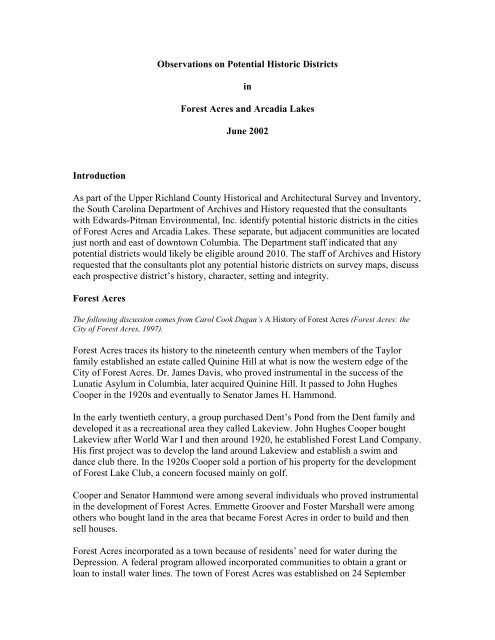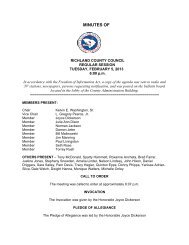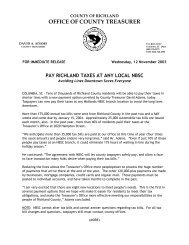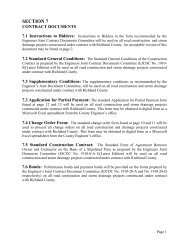Forest Acres and Arcadia Report - Richland County
Forest Acres and Arcadia Report - Richland County
Forest Acres and Arcadia Report - Richland County
Create successful ePaper yourself
Turn your PDF publications into a flip-book with our unique Google optimized e-Paper software.
Introduction<br />
Observations on Potential Historic Districts<br />
in<br />
<strong>Forest</strong> <strong>Acres</strong> <strong>and</strong> <strong>Arcadia</strong> Lakes<br />
June 2002<br />
As part of the Upper Richl<strong>and</strong> <strong>County</strong> Historical <strong>and</strong> Architectural Survey <strong>and</strong> Inventory,<br />
the South Carolina Department of Archives <strong>and</strong> History requested that the consultants<br />
with Edwards-Pitman Environmental, Inc. identify potential historic districts in the cities<br />
of <strong>Forest</strong> <strong>Acres</strong> <strong>and</strong> <strong>Arcadia</strong> Lakes. These separate, but adjacent communities are located<br />
just north <strong>and</strong> east of downtown Columbia. The Department staff indicated that any<br />
potential districts would likely be eligible around 2010. The staff of Archives <strong>and</strong> History<br />
requested that the consultants plot any potential historic districts on survey maps, discuss<br />
each prospective district’s history, character, setting <strong>and</strong> integrity.<br />
<strong>Forest</strong> <strong>Acres</strong><br />
The following discussion comes from Carol Cook Dugan’s A History of <strong>Forest</strong> <strong>Acres</strong> (<strong>Forest</strong> <strong>Acres</strong>: the<br />
City of <strong>Forest</strong> <strong>Acres</strong>, 1997).<br />
<strong>Forest</strong> <strong>Acres</strong> traces its history to the nineteenth century when members of the Taylor<br />
family established an estate called Quinine Hill at what is now the western edge of the<br />
City of <strong>Forest</strong> <strong>Acres</strong>. Dr. James Davis, who proved instrumental in the success of the<br />
Lunatic Asylum in Columbia, later acquired Quinine Hill. It passed to John Hughes<br />
Cooper in the 1920s <strong>and</strong> eventually to Senator James H. Hammond.<br />
In the early twentieth century, a group purchased Dent’s Pond from the Dent family <strong>and</strong><br />
developed it as a recreational area they called Lakeview. John Hughes Cooper bought<br />
Lakeview after World War I <strong>and</strong> then around 1920, he established <strong>Forest</strong> L<strong>and</strong> Company.<br />
His first project was to develop the l<strong>and</strong> around Lakeview <strong>and</strong> establish a swim <strong>and</strong><br />
dance club there. In the 1920s Cooper sold a portion of his property for the development<br />
of <strong>Forest</strong> Lake Club, a concern focused mainly on golf.<br />
Cooper <strong>and</strong> Senator Hammond were among several individuals who proved instrumental<br />
in the development of <strong>Forest</strong> <strong>Acres</strong>. Emmette Groover <strong>and</strong> Foster Marshall were among<br />
others who bought l<strong>and</strong> in the area that became <strong>Forest</strong> <strong>Acres</strong> in order to build <strong>and</strong> then<br />
sell houses.<br />
<strong>Forest</strong> <strong>Acres</strong> incorporated as a town because of residents’ need for water during the<br />
Depression. A federal program allowed incorporated communities to obtain a grant or<br />
loan to install water lines. The town of <strong>Forest</strong> <strong>Acres</strong> was established on 24 September
1935 with John Hughes Cooper as mayor. Eventually the town’s original boundaries<br />
exp<strong>and</strong>ed to the north.<br />
The town’s population exploded during the post-World War II era. In 1940, 323 people<br />
lived in <strong>Forest</strong> <strong>Acres</strong>. By 1950, the population had grown to 3,240. In 1970, the<br />
population stood at 6,808. By 1990, over seven thous<strong>and</strong> people lived in <strong>Forest</strong> <strong>Acres</strong>.<br />
<strong>Arcadia</strong> Lakes<br />
<strong>Arcadia</strong> Lakes was settled in the early twentieth century <strong>and</strong> became an incorporated<br />
community on 30 October 1959. In 1960, 316 residents lived in the town. By 1990 that<br />
number had grown to approximately 900. <strong>Arcadia</strong> Lakes occupies 2,228 acres.<br />
Recommendations<br />
In late October 2001, the consultants—using City of Columbia maps <strong>and</strong> a City of <strong>Forest</strong><br />
<strong>Acres</strong> map—conducted an extensive windshield survey over a two-day period. They<br />
drove every street <strong>and</strong> road in both cities <strong>and</strong> photographed several outst<strong>and</strong>ing examples<br />
of post-World War II domestic architecture.<br />
As a result of the survey, discussion with a few residents <strong>and</strong> research into the history of<br />
both cities, the consultants determined that potential historic districts could not be<br />
identified in either city. Several outst<strong>and</strong>ing early <strong>and</strong> mid-twentieth century dwellings<br />
st<strong>and</strong> in each city. <strong>Forest</strong> <strong>Acres</strong>, especially, possesses some of the most distinct post-war<br />
modernist houses in central South Carolina. In addition, each city might potentially hold<br />
significance in the area of social history as an example of suburban communities that<br />
developed during the post-World War II period. However, the consultants concluded that<br />
the resources that might potentially contribute to the significance of a district were<br />
distributed in a manner that compromised a potential district’s continuity. In other words,<br />
potentially contributing resources are interspersed with much later houses thereby<br />
compromising a potential district’s integrity. From the consultant’s observations, it<br />
appears that the growth each community experienced from the 1960s to the present has<br />
compromised the qualities of feeling <strong>and</strong> association necessary for the formation of a<br />
historic district.






